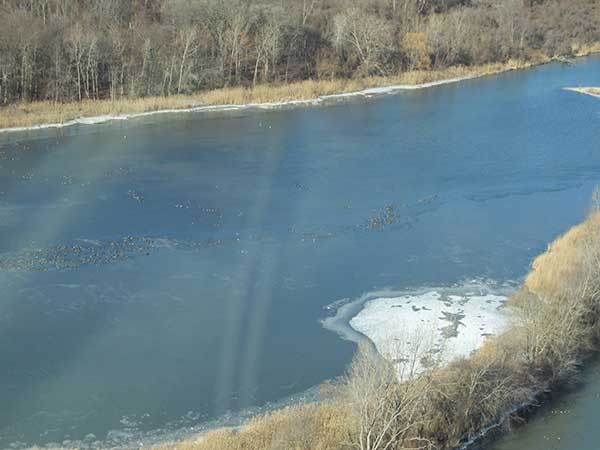(Provided by Michigan DNR)
 Michigan monitors waterfowl populations from the sky.
Michigan monitors waterfowl populations from the sky.
Michigan DNR wildlife staff members recently took to the sky in small aircraft to observe and count ducks, geese and swans on southeast Michigan's waterways this winter. They observed 157,028 ducks, 33,468 geese and 5,896 swans in the 2016 survey.
In the 2015 survey, observers counted 173,386 ducks, 20,350 geese and 4,365 swans. Goose and swan observations increased in 2016, while duck observations were down about 9 percent.
"The ducks were spread out this year with the mild winter and all the open water," said Joe Robison, field operations manager for the DNR Wildlife Division's Southeast Region. "We did not count as many ducks in this year's survey, but we believe that duck abundance is similar to last year."
Since 1991, the state of Michigan has cooperated with other states, the U. S. Fish and Wildlife Service, Canadian provinces and the Canadian Wildlife Service in conducting aerial surveys of wintering ducks and geese. This survey is commonly referred to as the Mid-Winter Waterfowl Survey.
Population estimates from Michigan, Minnesota and Wisconsin are included in estimates of waterfowl abundance and are needed for establishing annual waterfowl hunting season frameworks for the Mississippi, Central and Pacific Flyways. The Mid-Winter Waterfowl Survey has been especially important for evaluating waterfowl populations, monitoring winter migratory patterns and planning habitat management for these species.
Southeast Michigan, especially areas near western Lake Erie, the Detroit River and Lake St. Clair, is one of the most important areas in North America for migrating birds. Billions of birds migrate through this region each spring and fall. In addition, many waterfowl species spend the winter on the open water of the lakes and rivers of southeast Michigan.
The DNR, U.S. Fish and Wildlife Service and other partners are hosting a yearlong celebration of the 100th anniversary of the Migratory Bird Treaty. The celebration began Jan. 1, 2016.
The year 2016 marks the centennial of the Convention between the United States and Great Britain (for Canada) for the Protection of Migratory Birds (also called the Migratory Bird Treaty), signed Aug. 16, 1916. The Migratory Bird Treaty, three other treaties signed later, and the Migratory Bird Treaty Act form the cornerstones of efforts to conserve birds that migrate across international borders.
To learn more about the Migratory Bird Treaty centennial, visit www.fws.gov/birds/MBTreaty100.




